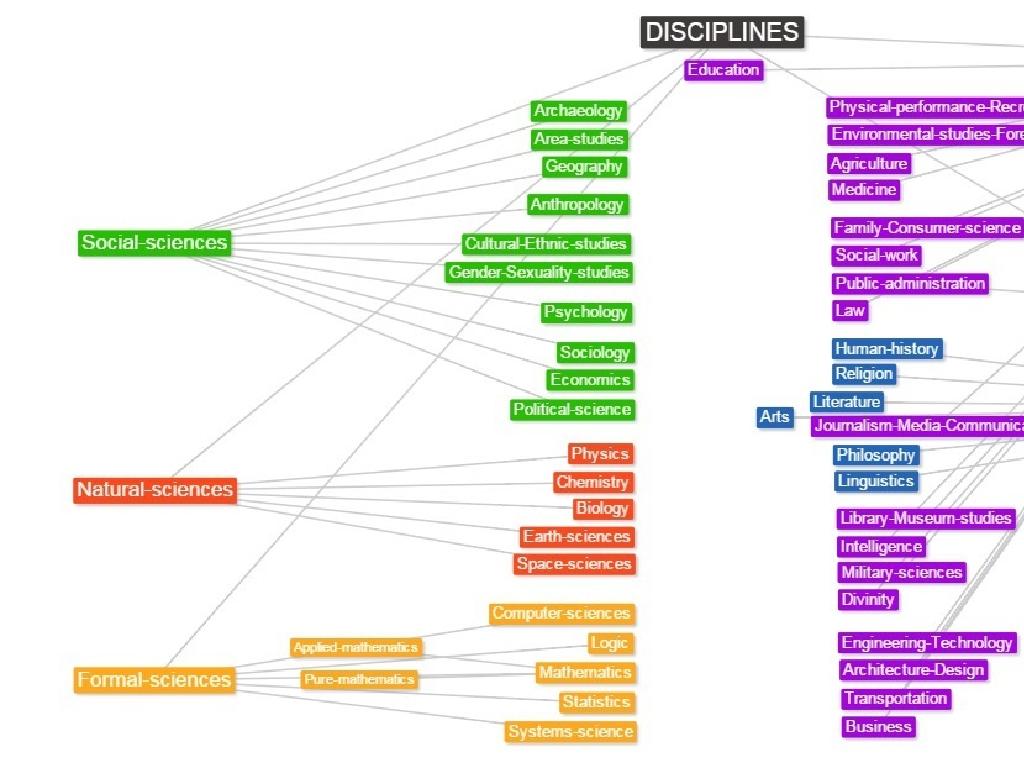Evaluate Radical Expressions
Subject: Math
Grade: Eighth grade
Topic: Expressions
Please LOG IN to download the presentation. Access is available to registered users only.
View More Content
Evaluating Radical Expressions
– Understanding radical importance
– Radicals allow us to work with roots and represent non-whole numbers.
– Overview of today’s lesson
– We’ll learn to evaluate and simplify radicals, and their role in math.
– Simplifying radical expressions
– Break down radicals to their simplest form for easier calculation.
– Applying radicals in equations
– Use radicals to solve real-world problems and algebraic equations.
|
Begin the lesson by explaining the concept of radicals and their significance in mathematics, particularly in representing the roots of numbers. Emphasize that understanding radicals is essential for higher-level math. Provide a roadmap of the lesson, which will include simplifying radical expressions and applying them to solve equations. Demonstrate the process of simplifying radicals by identifying perfect squares and cube roots. Show how these simplified forms can be used in various mathematical problems, including geometry and algebra. Encourage students to think of radicals as another tool in their math toolkit, useful for solving a wide range of problems.
Understanding Radical Expressions
– Define radical expressions
– An expression with a root, such as square or cube root
– Identify parts of a radical
– Radicand: number inside the root; Index: root degree; Radical sign:
– Examples of simple radicals
– 4 = 2, 9 = 3, ³ 8 = 2
– Practice evaluating radicals
|
Introduce the concept of radical expressions, which include numbers under a root symbol. Explain that the radicand is the number inside the root, the index indicates the degree of the root (e.g., square root, cube root), and the radical sign is the symbol that denotes the root ( ). Provide simple examples like the square root of 4 and 9, and the cube root of 8, to show how to evaluate basic radical expressions. Encourage students to practice with additional examples to gain confidence. This foundational knowledge will be crucial for understanding more complex operations involving radicals.
Properties of Radicals
– Product Property of Radicals
Multiplying radicals with the same index number
– Quotient Property of Radicals
Dividing radicals with the same index number
– Simplifying radical expressions
Use properties to combine and simplify radicals
– Practice problems
|
This slide introduces students to the fundamental properties of radicals that are crucial for simplifying radical expressions. The product property allows students to multiply radicals with the same index, while the quotient property enables them to divide radicals with the same index. Emphasize the importance of these properties in simplifying expressions, making complex problems more manageable. After explaining the properties, provide practice problems for students to apply what they’ve learned. Encourage them to work through the problems step-by-step and to ask questions if they encounter difficulties. This will help solidify their understanding and prepare them for more advanced operations involving radicals.
Simplifying Radical Expressions
– Identify perfect squares
– Find and extract squares like 16 = 4
– Simplify numerical radicands
– Reduce 50 to 5 2 by pulling out perfect squares
– Simplify variable radicands
– Simplify x² to x, assuming x is positive
– Practice with examples
|
This slide introduces the concept of simplifying radical expressions, a key skill in algebra. Start by explaining how to identify perfect squares within a radical and how to pull them out to simplify the expression. For numerical radicands, demonstrate the process of breaking down the radicand into its prime factors and then simplifying. When dealing with variable radicands, ensure students understand the assumption of variable being positive for simplification. Provide ample practice examples for students to apply these concepts, such as simplifying 18 or a²b. Encourage students to work through these examples and ask questions to solidify their understanding.
Adding and Subtracting Radical Expressions
– Understanding like and unlike radicals
– Like radicals have the same index and radicand, unlike do not.
– Rules for combining like radicals
– Add/subtract like radicals by combining their coefficients.
– Practice with adding and subtracting
– Solve example problems to apply the rules.
– Strategies for simplifying expressions
– Simplify radicals first, then follow addition/subtraction rules.
|
This slide introduces students to the concept of adding and subtracting radical expressions. Start by explaining like and unlike radicals, emphasizing that only like radicals can be combined. Review the rules for combining like radicals, which is similar to combining like terms in algebraic expressions. Provide practice problems to help students apply these rules and become comfortable with the process. Encourage students to simplify radical expressions before attempting to add or subtract, and remind them to look for opportunities to combine like radicals after simplification. This will prepare them for more complex operations involving radicals.
Multiplying Radical Expressions
– Use distributive property with radicals
– Similar to distributing numbers, but with roots involved
– Multiply binomials with radicals
– Apply FOIL method to products of binomials with radicals
– Work through example problems
– Demonstrate step-by-step multiplication of radicals
|
This slide introduces students to the concept of multiplying radical expressions. Start by explaining the distributive property as it applies to radicals, ensuring students understand that the process is similar to distribution with numbers, but they must consider the root values. Next, teach them how to multiply binomials containing radicals, using the FOIL (First, Outer, Inner, Last) method to find the product. Provide example problems that illustrate the process step-by-step, and encourage students to solve them independently. Emphasize the importance of simplifying the expressions after multiplication. This will prepare students for more complex algebraic operations involving radicals.
Rationalizing the Denominator
– Understanding denominator rationalization
– Rationalization makes numbers easier to work with.
– Steps to rationalize simple denominators
– Multiply numerator and denominator by the radical’s conjugate.
– Rationalizing complex denominators
– For complex cases, use conjugates or multiply by a suitable radical.
– Practice rationalization with problems
|
Rationalizing the denominator is a technique used to eliminate radicals from the bottom of a fraction. This process is important because it simplifies the expression and makes it easier to perform further arithmetic operations. Start by explaining why we rationalize denominators, emphasizing that it leads to more precise and simplified expressions. Demonstrate the process using both simple and complex examples. For simple denominators, show how multiplying by the radical’s conjugate can clear the radical. For complex denominators, explain the use of conjugates or multiplying by an appropriate radical to achieve rationalization. Provide practice problems that cover a range of difficulties to ensure students grasp the concept. Encourage students to work through these problems and be ready to discuss their solutions in the next class.
Solving Radical Equations
– Isolate the radical expression
– Move the radical to one side of the equation
– Raise both sides to the index’s power
– If the index is 2, square both sides to remove the radical
– Check for extraneous solutions
– Not all solutions may be valid; substitute back to check
– Practice with examples
– Solve x (x+3)=7 to apply these steps
|
This slide focuses on the steps to solve equations involving radicals. Start by isolating the radical on one side of the equation to simplify the problem. Next, eliminate the radical by raising both sides of the equation to the power of the radical’s index. After finding potential solutions, it’s crucial to check for extraneous solutions by substituting them back into the original equation, as the process of squaring both sides can introduce false solutions. Provide practice problems like x (x+3)=7 for students to apply these steps and reinforce their understanding. Encourage students to work through the problems step-by-step and verify their answers.
Class Activity: Radical Expressions Challenge
– Pair up and solve radical expressions
– Each pair explains one problem to class
– Choose a problem and prepare to present
– Discuss various solving methods
– Compare different approaches and shortcuts
– Reflect on the learning experience
– Share what was learned or any difficulties faced
|
This activity is designed to promote collaborative learning and peer teaching. By working in pairs, students can discuss and tackle the problems together, which can enhance their understanding of evaluating radical expressions. Each pair will take turns explaining their problem-solving process to the class, which will help reinforce their learning and provide different perspectives on solving similar problems. Encourage students to discuss not just the ‘how’ but also the ‘why’ behind the methods they used. As a teacher, facilitate the discussion by asking probing questions and highlighting various strategies. Possible activities for different pairs could include simplifying radicals, adding and subtracting radical expressions, and multiplying and dividing radicals. Ensure that each pair has a different problem to present to encourage a wide range of examples and methods.
Wrapping Up: Radical Expressions
– Recap on radical expressions
– Review the steps to evaluate square roots and cube roots.
– Practice makes perfect
– Consistent practice is key to mastering math skills.
– Homework assignment
– Solve problems 5-10 on page 47 of the textbook.
|
As we conclude today’s lesson, it’s important to summarize the key points about evaluating radical expressions. Remind students that understanding radicals is crucial for their progress in algebra. Emphasize the importance of practice in mastering these concepts. For homework, assign specific problems that reinforce today’s lesson, ensuring the problems vary in difficulty to challenge all students. Encourage them to attempt the problems without assistance initially, then review their work with peers or seek help if necessary. This will prepare them for the next class where we will discuss their solutions and address any difficulties encountered.






